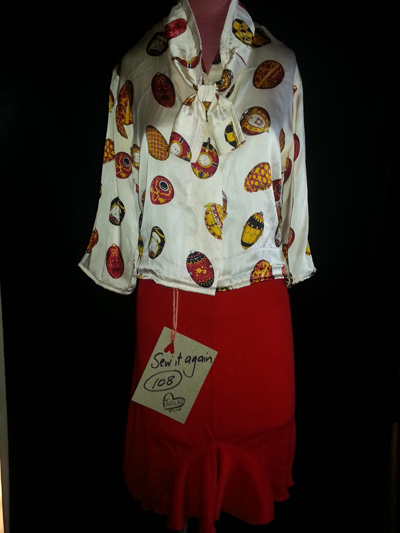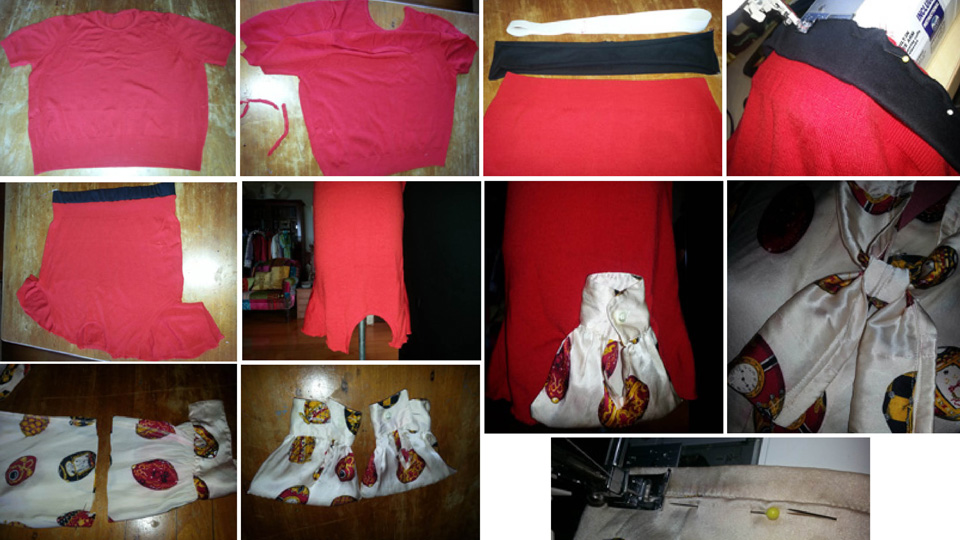 Weird, eccentric, alternative, unusual, different, unique, junky, ragged, rustic, rough, bodgie, wasted, original, rad, scrappy, yuck, quirky, bespoke, creative … adjectives describing various results from taking scissors to existing clothes and resewing them.
Weird, eccentric, alternative, unusual, different, unique, junky, ragged, rustic, rough, bodgie, wasted, original, rad, scrappy, yuck, quirky, bespoke, creative … adjectives describing various results from taking scissors to existing clothes and resewing them.
There are professional designers creating cutting-edge clothing from upcycled materials all over the world, with the best collated by New York-based academic Sass Brown in her latest book Refashioned and website Eco Fashion Talk.
I’m an amateur, learning by doing, having a go with what I have, resewing rejected natural fibre clothing using home-sewing techniques and posting results on sewitagain.com every day this year.
One doesn’t have to look far to see evidence of clothing waste, millions of tonnes of it every year. Americans throw out 30kg of textiles per person per year, according to Elizabeth Cline in Overdressed: the Shockingly High Cost of Cheap Fashion. And at least half of donated clothing ends up being shipped overseas to African countries, according to Beverly Gordon in her book Textiles: The Whole Story.
According to FAO figures, the 2010 per capita consumption of apparel fibre was 11kg. Put another way that means, on average, every person in the world adds 11kg of clothing to their wardrobe each year. Most clothing doesn’t get a chance to wear out – it is tossed out to make way for new season trends, or to save the bother of washing/mending small imperfections.
This is unsustainable in a finite world. The race to the bottom means new clothing becomes cheaper as global supply chains churn out hot new looks from sweatshops (think Rana Plaza, Bangladesh) every time you turn around.
When my op-shop habit resurfaced (after years in abeyance), I noticed an incredible abundance of unmarked, sometimes unworn, clothing. Beverly Gordon writes: “Wealthy countries have an incredible glut of usable clothing; garments are relatively inexpensive to purchase and the international cosmopolitan fashion system demands (my emphasis) that we replace clothes quickly in order to stay in style.”
Take all of the above and segue into my wholehearted and authentic leadership intent to:
- Upcycle every day on sewitagain.com to demonstrate an alternate way
- Empower others by sharing ideas for the mindful craft of upcycling by resewing
- Shift society’s thinking about ecological impacts of clothing choices
 If upcycling is not for you, there are many other ways to be part of the Fashion Revolution. Buy ethical and local, vintage or second-hand, sustainable fibres, swap and share. And on April 24, the anniversary of the Rana Plaza factory collapse, turn what you are wearing inside out, take a selfie and post it on social media with the hashtag #insideout. Who made it, what from and where? Be curious, find out, do something.
If upcycling is not for you, there are many other ways to be part of the Fashion Revolution. Buy ethical and local, vintage or second-hand, sustainable fibres, swap and share. And on April 24, the anniversary of the Rana Plaza factory collapse, turn what you are wearing inside out, take a selfie and post it on social media with the hashtag #insideout. Who made it, what from and where? Be curious, find out, do something.
I had fun chatting to ABC Local Radio’s Rebecca Levingston last night about these issues – listen here.
This jumper to skirt conversion is easy and therefore one of my favourite upcycles. Sew 108 was a red woollen top which I’ve turned upside down, cut across the shoulders for a ragged hemline (with sleeves/neckline left in place, and raw edges zigzagged to limit unravelling). To extend the length of the skirt, I added a piece of black lycra to the waist which becomes a waistband with elastic inserted. I’ve teamed the skirt with a silk top, upcycled by trimming the hem and turning it into a ribbon tie at the neck. I cut off the cuffs to soften the look of the sleeves, and the offcuts can be used for skirt embellishment. The skirt is worn with the former side-seams sitting to the front and back, so curves from the old neckline are placed at the sides. Sewing the cuffs to cover the former neckline curve may also serve as a phone pouch.
